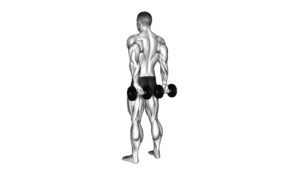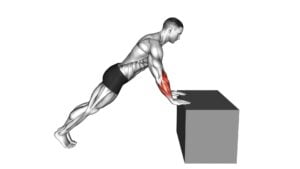Dumbbell Behind Back Finger Curl (female) – Video Exercise Guide & Tips

Looking to strengthen your grip and develop your forearm muscles? Check out this video exercise guide for the Dumbbell Behind Back Finger Curl.
Watch This Exercise Video
In this workout, you'll learn the proper form and technique for this exercise, as well as variations for different fitness levels.
Avoid common mistakes and maximize your grip strength with these helpful tips.
Get ready to elevate your training routine and achieve those fitness goals!
Key Takeaways
- The Dumbbell Behind Back Finger Curl strengthens grip and forearm muscles.
- It improves hand dexterity and enhances fine motor skills.
- This exercise reduces the risk of finger and hand injuries.
- Athletes and individuals wanting to improve grip strength can benefit from this exercise.
Benefits of the Dumbbell Behind Back Finger Curl
To maximize your finger strength and flexibility, incorporate the dumbbell behind back finger curl into your workout routine. This exercise offers numerous benefits, including injury prevention and hand dexterity improvement.
By strengthening the muscles in your fingers and hands, you can reduce the risk of common injuries such as sprains and strains. Additionally, the dumbbell behind back finger curl helps to improve hand dexterity, allowing for better control and coordination in everyday activities. Whether you're an athlete looking to improve your grip strength or someone wanting to enhance their fine motor skills, this exercise is highly effective.
Proper form and technique for the dumbbell behind back finger curl are essential to reap the full benefits. Begin by standing tall with your feet shoulder-width apart. Hold a dumbbell in one hand, with your palm facing towards your body. Gradually curl your fingers around the dumbbell, squeezing tightly. Keep your wrist straight and your arm close to your body throughout the movement. Slowly lower the dumbbell back to the starting position and repeat for the desired number of repetitions. Remember to maintain control and focus on engaging the muscles in your fingers and hands throughout the exercise.
Proper Form and Technique for the Exercise
To ensure proper form and technique for the dumbbell behind back finger curl, it's crucial that you maintain a straight wrist and keep your arm close to your body throughout the exercise. This exercise primarily targets the finger flexor muscles, which are responsible for gripping and squeezing motions. By performing this exercise correctly, you can strengthen these muscles and improve your grip strength.
Maintaining a straight wrist is important because it helps to isolate the finger flexor muscles and prevents unnecessary strain on the wrist joint. By keeping your arm close to your body, you engage the muscles in your upper arm and shoulder, providing stability and support during the exercise.
It's also important to note that proper form and technique can help prevent common finger injuries, such as sprains and strains. By using correct form and not overloading the weight, you reduce the risk of putting excessive stress on your fingers and joints.
If you find the dumbbell behind back finger curl challenging or uncomfortable, there are alternative grip exercises that you can try. These include using a resistance band, grip strengtheners, or performing finger curls with a lighter weight. Experimenting with different exercises can help you find the one that best suits your needs and abilities.
Variations and Modifications for Different Fitness Levels
There are several variations and modifications available for individuals of different fitness levels looking to perform the dumbbell behind back finger curl exercise. For advanced athletes who want to progress and challenge themselves further, they can increase the weight of the dumbbell or use a resistance band for added resistance. This will help to further strengthen the finger extensor muscles and improve grip strength.
On the other hand, individuals with wrist or hand injuries may need to modify the exercise to avoid further strain or discomfort. One modification option is to use a lighter dumbbell or even a soft foam ball to reduce the amount of stress on the injured area. Another modification is to perform the exercise with the palm facing upwards, which can help alleviate pressure on the wrist.
It is important to listen to your body and consult with a healthcare professional or a qualified fitness trainer before attempting any modifications. They can provide guidance on the appropriate modifications based on your specific condition and goals.
Common Mistakes to Avoid While Performing the Exercise
When performing the dumbbell behind back finger curl exercise, be cautious of common mistakes that can hinder your progress and increase the risk of injury.
One common mistake is using too heavy of a weight. It may be tempting to lift a heavier dumbbell to feel stronger, but using excessive weight can strain your fingers and wrists. To avoid this, start with a lighter weight and gradually increase as your strength improves.
Another mistake isn't maintaining proper form. It's important to keep your back straight and shoulders pulled back throughout the exercise. Avoid rounding your back or hunching your shoulders, as this can lead to poor posture and potential back injuries. Additionally, make sure to fully extend your fingers and curl them back as far as possible to engage the muscles properly.
Improper grip is also a common mistake. Make sure to hold the dumbbell securely with your fingers wrapped around it, rather than gripping it with your palm. This will target the finger muscles more effectively and prevent unnecessary strain on your wrists.
To improve your performance, practice proper technique and start with lighter weights. Focus on maintaining good form throughout the exercise and ensure a secure grip on the dumbbell.
Tips for Maximizing Grip Strength and Forearm Development
To maximize your grip strength and develop your forearms, focus on incorporating exercises that target these specific areas. Improving grip strength is essential for various activities such as weightlifting, rock climbing, and even everyday tasks like carrying groceries. Strong forearms are also important for overall upper body strength and stability. Fortunately, there are several effective forearm exercises that can help you achieve these goals.
One of the best exercises for improving grip strength and forearm development is the farmer's walk. This exercise involves holding heavy dumbbells or kettlebells in each hand and walking for a certain distance or time. The constant tension on the forearms helps build endurance and strength.
Another effective exercise is the wrist roller. This simple yet challenging exercise involves rolling a weight up and down using only your wrists. It targets the muscles in the forearms, improving grip strength and forearm endurance.
Incorporating exercises that involve gripping and squeezing objects, such as grip strengtheners or stress balls, can also be beneficial. These exercises can be done anywhere and at any time, making them convenient for improving grip strength throughout the day.
Remember to start with lighter weights and gradually increase the resistance as your grip strength improves. Consistency is key, so aim to incorporate forearm exercises into your regular workout routine at least two to three times a week. By following these tips and incorporating forearm exercises into your training program, you can maximize your grip strength and develop strong forearms.
Frequently Asked Questions
How Many Sets and Reps Should I Do for the Dumbbell Behind Back Finger Curl Exercise?
For the dumbbell behind back finger curl exercise, it's important to consider the number of sets and reps you should do.
To determine this, you need to consider your progression rate and goals. Start with a weight that challenges you but allows you to maintain proper form.
Aim for 2-3 sets of 8-12 reps initially and gradually increase the weight and intensity as you progress.
Remember to listen to your body and adjust accordingly to avoid injury.
Can I Use Wrist Wraps or Straps While Performing This Exercise?
Yes, you can use wrist wraps or straps while performing the dumbbell behind back finger curl exercise. Using wrist wraps or straps can provide extra support and help prevent grip fatigue.
However, it's important to note that using these aids may reduce the activation of the finger flexor muscles.
If you want to challenge your grip strength further, you can try alternative variations of the exercise, such as using a thicker grip or increasing the weight of the dumbbell.
Is This Exercise Suitable for Individuals With Wrist or Hand Injuries?
If you have wrist or hand injuries, it's important to be cautious with exercises that may aggravate them. The Dumbbell Behind Back Finger Curl may not be suitable for individuals with these injuries.
However, there are alternative exercises and modifications that can be done to work the same muscles without putting strain on your wrists or hands.
It's always best to consult with a healthcare professional or a certified trainer for personalized recommendations based on your specific condition.
Can I Do This Exercise With a Barbell Instead of Dumbbells?
Barbell vs. Dumbbell: Which is better for finger curls?
When it comes to finger curls, both barbells and dumbbells can be effective.
Barbells offer a greater challenge as they require more stability and coordination.
However, dumbbells provide more freedom of movement for each hand, allowing for better isolation of the fingers.
If you're looking for alternatives to dumbbell behind back finger curls, you can explore exercises like wrist curls, reverse curls, or even using resistance bands.
Tailor your choice based on your specific goals and preferences.
How Long Does It Take to See Results in Terms of Grip Strength and Forearm Development From This Exercise?
To see results in grip strength and forearm development from this exercise, it's important to be consistent and patient.
Results can vary depending on various factors like genetics and training intensity. However, with regular practice and proper progression strategies, you can start noticing improvements within a few weeks.
Conclusion
In conclusion, the dumbbell behind back finger curl is an effective exercise for improving grip strength and forearm development.
By following proper form and technique, individuals can benefit from this exercise at all fitness levels.
It's important to avoid common mistakes and make necessary variations to suit one's abilities.
By consistently practicing this exercise, individuals can maximize their grip strength and achieve their fitness goals.

Author
Years ago, the spark of my life’s passion ignited in my mind the moment I stepped into the local gym for the first time. The inaugural bead of perspiration, the initial endeavor, the very first surge of endorphins, and a sense of pride that washed over me post-workout marked the beginning of my deep-seated interest in strength sports, fitness, and sports nutrition. This very curiosity blossomed rapidly into a profound fascination, propelling me to earn a Master’s degree in Physical Education from the Academy of Physical Education in Krakow, followed by a Sports Manager diploma from the Jagiellonian University. My journey of growth led me to gain more specialized qualifications, such as being a certified personal trainer with a focus on sports dietetics, a lifeguard, and an instructor for wellness and corrective gymnastics. Theoretical knowledge paired seamlessly with practical experience, reinforcing my belief that the transformation of individuals under my guidance was also a reflection of my personal growth. This belief holds true even today. Each day, I strive to push the boundaries and explore new realms. These realms gently elevate me to greater heights. The unique combination of passion for my field and the continuous quest for growth fuels my drive to break new ground.







